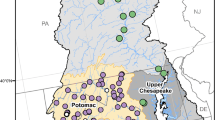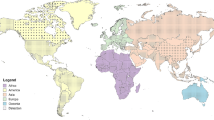Abstract
Endocrine-disrupting compounds (EDCs) are becoming of increasing concern in waterways of the USA and worldwide. What remains poorly understood, however, is how prevalent these emerging contaminants are in the environment and what methods are best able to determine landscape sources of EDCs. We describe the development of a spatially structured sampling design and a reconnaissance survey of estrogenic activity along gradients of land use within sub-watersheds. We present this example as a useful approach for state and federal agencies with an interest in identifying locations potentially impacted by EDCs that warrant more intensive, focused research. Our study confirms the importance of agricultural activities on levels of a measured estrogenic equivalent (E2Eq) and also highlights the importance of other potential sources of E2Eq in areas where intensive agriculture is not the dominant land use. Through application of readily available geographic information system (GIS) data, coupled with spatial statistical analysis, we demonstrate the correlation of specific land use types to levels of estrogenic activity across a large area in a consistent and unbiased manner.



Similar content being viewed by others
References
Alvarez, D. A., Shappell, N. W., Billey, L. O., Bermudez, D. S., Wilson, V. S., Kolpin, D. W., et al. (2013). Bioassay of estrogenicity and chemical analyses of estrogens in streams across the United States associated with livestock operations. Water Research, 47, 3347–3363.
Andaluri, G., Suri, R. P. S., & Kumar, K. (2012). Occurrence of estrogen hormones in biosolids, animal manure, and mushroom compost. Environmental Monitoring and Assessment, 184, 1197–1205.
Anderson, P. D., Johnson, A. C., Pfeiffer, D., Caldwell, D. J., Hannah, R., Mastrocco, F., et al. (2012). Endocrine disruption due to estrogens derived from humans predicted to be low in the majority of U.S. surface waters. Environmental Toxicology and Chemistry, 31(6), 1407–1415.
Ator, S.W., Brakebill, J.W., &Blomquist, J.D. (2011) Sources, fate, and transport of nitrogen and phosphorus in the Chesapeake Bay watershed—an empirical model. U.S. Geological Survey Scientific Investigations Report 2011–5167, 27 p. (also available at http://pubs.usgs.gov/sir/2011/5167/.)
Barber, L. B., Vajda, A. M., Douville, C., Norris, D. O., & Writer, J. H. (2012). Fish endocrine disruption response to a major wastewater treatment facility upgrade. Environmental Science and Technology, 46(4), 2121–2131.
Barnes, K. K., Kolpin, D. W., Furlong, E. T., Zaugg, S. D., Meyer, M. T., & Barber, L. B. (2008). A national reconnaissance of pharmaceuticals and other organic wastewater contaminants in the United States—I. Groundwater. The Science of the Total Environment, 402(2–3), 192–200.
Beale, L., Abellan, J. J., Hodgson, S., & Jarup, L. (2008). Methodologic issues and approaches to spatial epidemiology. Environmental Health Perspectives, 116(8), 1105–1110.
Blazer, V. S., Iwanowicz, L. R., Iwanowicz, D. D., Smith, D. R., Young, J. A., Hedrick, J. D., et al. (2007). Intersex (testicular oocytes) in smallmouth bass from the Potomac River and selected nearby drainages. Journal of Aquatic Animal Health, 19(4), 242–253.
Blazer, V., Iwanowicz, L., Starliper, C., Iwanowicz, D., Barbash, P., Hedrick, J., et al. (2010). Mortality of centrarchid fishes in the Potomac drainage: survey results and overview of potential contributing factors. Journal of Aquatic Animal Health, 22(December), 190–218.
Blazer, V. S., Iwanowicz, L. R., Henderson, H., Mazik, P. M., Jenkins, J. A., Alvarez, D. A., et al. (2012). Reproductive endocrine disruption in smallmouth bass (Micropterus dolomieu) in the Potomac River basin: spatial and temporal comparisons of biological effects. Environmental Monitoring and Assessment, 184(7), 4309–4334.
Burkhardt-Holm, P. (2010). Endocrine disruptors and water quality: a state-of-the-art review. International Journal of Water Resources Development, 26(3), 477–493.
Ciparis, S., Iwanowicz, L. R., & Voshell, J. R. (2012). Effects of watershed densities of animal feeding operations on nutrient concentrations and estrogenic activity in agricultural streams. The Science of the Total Environment, 414, 268–276.
Dussault, È. B., Sherry, J. P., Lee, H.-B., Burnison, B. K., Bennie, D. T., & Servos, M. R. (2005). In vivo estrogenicity of nonylphenol and its ethoxylates in the Canadian environment. Human and Ecological Risk Assessment, 11, 353–364.
Dutta, S. K., Inamdar, S. P., Tso, J., & Aga, D. S. (2012). Concentrations of free and conjugated estrogens at different landscape positions in an agricultural watershed receiving poultry litter. Water, Air, & Soil Pollution, 223(5), 2821–2836.
Dyer, A. R., Raman, D. R., Mullen, M. D., Burns, R. T., Moody, L. B., Layton, A. C., et al. (2001). Determination of 17β-estradiol concentrations in runoff from plots receiving dairy manure. St. Joseph: ASAE Meeting paper; No. 01-2107; ASAE.
Ebert, D.W. & Wade, T.G. (2004) Analytical Tools Interface for Landscape Assessments (ATtILA): user manual. US Environmental Protection Agency, Office of Research and Development, EPA/600/R-04/083. 39 pp.
Elliott, P., & Wartenberg, D. (2004). Spatial epidemiology: current approaches and future challenges. Environmental Health Perspectives, 112(9), 998–1006.
Finlay-Moore, O., Hartel, P. G., & Cabrera, M. L. (2000). 17β-Estradiol and testosterone in soil and runoff from grasslands amended with broiler litter. Journal of Environmental Quality, 29, 1604–1611.
Focazio, M. J., Kolpin, D. W., Barnes, K. K., Furlong, E. T., Meyer, M. T., Zaugg, S. D., et al. (2008). A national reconnaissance for pharmaceuticals and other organic wastewater contaminants in the United States—II. Untreated drinking water sources. The Science of the Total Environment, 402(2–3), 201–216.
Foley, J. E., Queen, E. V., Sacks, B., & Foley, P. (2005). GIS-facilitated spatial epidemiology of tick-borne diseases in coyotes (Canis latrans) in northern and coastal California. Comparative Immunology, Microbiology and Infectious Diseases, 28(3), 197–212.
Fotheringham, S. A., Brunsdon, C., & Charlton, M. (2002). Geographically weighted regression: the analysis of spatially varying relationships. New York: Wiley.
Hanselman, T., Graetz, D., & Wilkie, A. (2003). Manure-borne estrogens as potential environmental contaminants: a review. Environmental Science andTechnology, 37(24), 5471–5478.
Hensel, D. R. (2006). Fabricating data: how substituting values for nondetects can ruin results, and what can be done about it. Chemosphere, 65, 2434–2439.
Herlihy, A., & Larsen, D. (2000). Designing a spatially balanced, randomized site selection process for regional stream surveys: the EMAP Mid-Atlantic pilot study. Environmental Monitoring and Assessment, 63, 95–113.
Hirakawa, L., Miyagawa, S., Katsu, Y., Kagami, Y., Tatarzako, N., Kobayashi, T., et al. (2012). Gene expression profiles in the testis association with testis-ova in adult Japanese medaka (Oryzias latipes) exposed to 17α-ethinylestradiol. Chemosphere, 87, 668–674.
Holdenrieder, O., Pautasso, M., Weisberg, P. J., & Lonsdale, D. (2004). Tree diseases and landscape processes: the challenge of landscape pathology. Trends in Ecology & Evolution, 19(8), 446–452.
Irani, F.M. and P. Claggett. 2010. Chesapeake Bay watershed land cover data series. US Geological Survey Data Series 2010-505. [ftp://ftp.chesapeakebay.net/Gis/CBLCD_Series/].
Iwanowicz, L.R &Ottinger, C. A. (2009) Estrogens, estrogen receptors and their role as immunoregulators in fish. In: Fish defenses, volume 1: immunology. Eds. G. Zaccone, J. Meseguer, A. Garcia-Ayala, and B.G. Kapoor. Science, Enfield. Pp. 277-322.
Iwanowicz, L. R., Blazer, V. S., Guy, C. P., Pinkney, A. E., Mullican, J. E., & Alvarez, D. A. (2009). Reproductive health of bass in the Potomac, U.S.A., drainage: part 1. Exploring the effects of proximity to wastewater treatment plant discharge. Environmental Toxicology and Chemistry / SETAC, 28(5), 1072–1083.
Jarque, C. M., & Bera, A. K. (1987). A test for normality of observations and regression residuals. International Statistical Review, 55(2), 163–172.
Jobling, S., Beresford, N., Nolan, M., Rodgers-Gray, T., Brighty, G. C., Sumpter, J. P., et al. (2002). Altered sexual maturation and gamete production in wild roach (Rutilus rutilus) living in rivers that receive treated sewage effluents. Biology of Reproduction, 66, 272–281.
Jobling, S., Williams, R., Johnson, A., Taylor, A., Gross-Sorokin, M., Nolan, M., et al. (2006). Predicted exposures to steroid estrogens in U.K. rivers correlate with widespread sexual disruption in wild fish populations. Environmental Health Perspectives, 114, 32–39.
Kerdivel, G., Habauzit, D., & Pakdel, F. (2013). Assessment and molecular actions of endocrine-disrupting chemicals that interfere with estrogen receptor pathways. International Journal of Endocrinology, 501851, 14. doi:10.1155/2013/501851.
Khanal, S., Xie, B., Thompson, M., Sung, S., Ong, S.-K., & Van Leeuwen, J. (2006). Critical review: fate, transport, and biodegradation of natural estrogens in the environment and engineered systems. Environmental Science and Technology, 40(21), 6537–6546.
Kidd, K. A., Blanchfield, P. J., Mills, K. H., Palace, V. P., Evans, R. E., Lazorchak, J. M., et al. (2007). Collapse of a fish population after exposure to a synthetic estrogen. Proceedings of the National Academy of Sciences, 104, 8897–8901.
Kolpin, D. W., Furlong, E. T., Meyer, M. T., Thurman, E. M., Zaugg, S. D., Barber, L. B., et al. (2002). Pharmaceuticals, hormones, and other organic wastewater contaminants in U.S. streams, 1999–2000: a national reconnaissance. Environmental Science & Technology, 36(6), 1202–1211.
Kolpin, D. W., Blazer, V. S., Gray, J. L., Focazio, M. J., Young, J. A., Alvarez, D. A., et al. (2013). Chemical contaminants in water and sediment near fish nesting sites in the Potomac River basin: determining potential exposures to smallmouth bass (Micropterus dolomieu). The Science of the Total Environment, 443, 700–716.
Leet, J. K., Lee, L. S., Gall, H. E., Goforth, R. R., Sassman, S., Gordon, D. A., et al. (2012). Assessing impacts of land-applied manure from concentrated animal feeding operations on fish populations and communities. Environmental Science & Technology, 46(24), 13440–13447.
Leusch, F. D. L., De Jager, C., Levi, Y., Lim, R., Puijker, L., Sacher, F., et al. (2010). Comparison of five in vitro bioassays to measure estrogenic activity in environmental waters. Environmental Science and Technology, 44, 3853–3860.
Li, W., Seifert, M., Xu, Y., & Hock, B. (2004). Comparative study of estrogenic potencies of estradiol, tamoxifen, bispheol-A and resveratrol with two in vitro bioassays. Environment International, 30, 329–335.
Meentemeyer, R. K., Haas, S. E., & Václavík, T. (2012). Landscape epidemiology of emerging infectious diseases in natural and human-altered ecosystems. Annual Review of Phytopathology, 50, 379–402.
Metcalfe, C. D., Kleywegt, S., Fletcher, R. J., Topp, E., Wagh, P., Trudeau, V. L., et al. (2013). A multi-assay screening approach for assessment of endocrine-active contaminants in wastewater effluent samples. The Science of the Total Environment, 454–455, 132–140.
Miller, M. W., & Conner, M. M. (2005). Epidemiology of chronic wasting disease in free-ranging mule deer: spatial, temporal, and demographic influences on observed prevalence patterns. Journal of Wildlife Diseases, 41(2), 275–290.
Moore, D. A., & Carpenter, T. E. (1999). Spatial analytical methods and geographic information systems: use in health research and epidemiology. Epidemiologic Reviews, 21(2), 143–161.
Nichols, D. J., Daniel, T. C., Edwards, D. R., Moore, P. A., & Pote, D. H. (1998). Use of grass filter strips to reduce 17 beta-estradiol in runoff from fescue-applied poultry litter. Journal of Soil and Water Conservation, 53, 74–77.
Ostfeld, R. S., Glass, G. E., & Keesing, F. (2005). Spatial epidemiology: an emerging (or re-emerging) discipline. Trends in Ecology & Evolution, 20(6), 328–336.
Paulson, S. G., Mayio, A., Peck, D. V., Stoddard, J. L., Tarquinio, E., Holdsworth, S. M., et al. (2008). Condition of stream ecosystems in the US: an overview of the first national assessment. Journal of the North American Benthological Society, 27(4), 812–821.
Peterson, E. W., Davis, R. K., & Orndorff, H. A. (2000). 17β-Estradiol as an indicator of animal waste contamination in mantled karst aquifers. Journal of Environmental Quality, 29, 826–834.
Quinn-Hosey, K. M., Roche, J. J., Fogarty, A. M., & Brougham, C. A. (2012). Screening for genotoxicity and oestrogenicity of endocrine disrupting compounds in vitro. Journal of Environmental Protection, 3, 902–914.
Richardson, S. D., & Ternes, T. A. (2011). Water analysis: emerging contaminants and current issues. Analytical Chemistry, 83, 4614–4648.
Robertson, L. S., Iwanowicz, L. R., & Marranca, J. M. (2009). Identification of centrarchidhepcidins and evidence that 17β-estradiol disrupts constitutive expression of hepcidin-1 and inducible expression of hepcidin-2 in largemouth bass. Fish & Shellfish Immunology, 26, 898–907.
Rotroff, D. M., Dix, D. J., Houck, K. A., Knudsen, T. B., Martin, M. T., McLaurin, K. W., et al. (2013). Using in vitro high throughput screening assays to identify potential endocrine-disrupting chemicals. Environmental Health Perspectives, 121, 7–14.
Sanseverino, J., Eldridge, M. L., Layton, A. C., Easter, J. P., Yarbrough, J., Schultz, T. W., et al. (2009). Screening of potentially hormonally active chemicals using bioluminescent yeast bioreporters. Toxicological Sciences, 107(1), 122–134.
Sheridan, H. A., McGrath, G., White, P., Fallon, R., Shoukri, M. M., & Martin, S. W. (2005). A temporal–spatial analysis of bovine spongiform encephalopathy in Irish cattle herds, from 1996 to 2000. Canadian Journal of Veterinary Research, 69(1), 19–25.
Shore, L. S., & Shemesh, M. (2003). Naturally produced steroid hormones and their release into the environment. Pure and Applied Chemistry, 75(11–12), 1859–1871.
Snow, D. D., Bartlet-Hunt, S. L., Devivo, S., Saunder, S., & Cassada, D. A. (2009). Detection, occurrence, and fate of emerging contaminants in agricultural environments. Water Environment Research, 81(10), 941–958.
Stavreva, D. A., George, A. A., Klausmeyer, P., Varticovski, L., Sack, D., Voss, T. C., Schiltz, R. L., Blazer, V.S., Iwanowicz, L.R., and Hager, G.L. (2012) Prevalent glucocorticoid and androgen activity in US water sources. Science Reports2 (937) [doi: 10.1038/srep00937]
Stevens, D. L. J., & Olsen, A. (2004). Spatially balanced sampling of natural resources. Journal of the American Statistical Association, 99(465), 262–278.
Tanna, R. N., Tetreault, G. R., Bennett, C. J., Smith, B. M., Bragg, L. M., Oakes, K. D., et al. (2013). Occurrence and degree of intersex (testis-ova) in darters (Etheostoma spp.) across an urban gradient in the Grand River, Ontario, Canada. Environmental Toxicology Chemistry, 32(9), 1981–1991.
Tetreault, G. R., Bennett, C. J., Shires, K., Knight, B., Servos, M. R., & McMaster, M. E. (2011). Intersex and reproductive impairment of wild fish exposed to multiple municipal wastewater discharges. Aquatic Toxicology, 104, 278–290.
Tran, L. T., Knight, C. G., O’Neill, R. V., Smith, E. R., Riitters, K. H., & Wickham, J. (2002). Fuzzy decision analysis for integrated environmental vulnerability assessment of the mid-Atlantic Region. Environmental Management, 29(6), 845–859.
US-EPA. (2009). Targeted national sewage sludge survey sampling and analysis technical report. Washington, DC: Office of Water. EPA-822-R-08-016.
Vajda, A. M., Barber, L. B., Gray, J. L., Lopez, E. M., Woodling, J. D., & Norris, D. O. (2008). Reproductive disruption in fish downstream of an estrogenic wastewater effluent. Environmental Science & Technology, 42(9), 3407–3414.
Zacharewski, T. (1997). In vitro bioassays for assessing estrogenic substances. Environmental Science & Technology, 31(3), 613–623.
Acknowledgments
This research was funded by the USGS Priority Ecosystems Program. We thank John B. Churchill and Rachel Shirley for assistance with GIS analysis and Marcus Springmann for assistance in the collection of water samples. We also thank John Sanseverino (Center for Environmental Biotechnology, University of Tennessee) for the strain BLYES. Any use of trade names does not imply endorsement by the US Government.
Author information
Authors and Affiliations
Corresponding author
Rights and permissions
About this article
Cite this article
Young, J., Iwanowicz, L., Sperry, A. et al. A landscape-based reconnaissance survey of estrogenic activity in streams of the upper Potomac, upper James, and Shenandoah Rivers, USA. Environ Monit Assess 186, 5531–5545 (2014). https://doi.org/10.1007/s10661-014-3801-y
Received:
Accepted:
Published:
Issue Date:
DOI: https://doi.org/10.1007/s10661-014-3801-y




